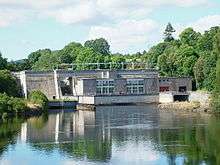Affric-Beauly hydro-electric power scheme
The Affric / Beauly hydro-electric power scheme for the generation of hydro-electric power is located in the western Highlands of Scotland. It is based around Glen Strathfarrar, Glen Cannich and Glen Affric, and Strathglass further downstream.
The scheme was developed by the North of Scotland Hydro-Electric Board, with plans being approved in 1947.
The largest dam of the scheme is at Loch Mullardoch, at the head of Glen Cannich. From there, a tunnel takes water to Loch Beinn a' Mheadhoinn (Loch Benevean) in Glen Affric, via a small underground power station near Mullardoch dam. Loch Benevean is also dammed, with a tunnel taking water to the main power station of Fasnakyle, near Cannich.
To the north in Glen Strathfarrar, Loch Monar is dammed, and a 9 km tunnel carries water to an underground power station at Deanie. Further down the glen, the River Farrar is dammed just below Loch Beannacharan, with a tunnel to take water to Culligran power station (also underground).
The River Farrar joins with the River Glass near Struy to form the River Beauly. Downstream on the River Beauly, dams and power stations have been built in gorges at Aigas and Kilmorack.
As the rivers in this scheme are important for Atlantic salmon, flow in the rivers is kept above agreed levels. The dams at Kilmorack, Aigas and Beannacharn contain Borland fish lifts to allow salmon to pass.
Today the scheme is owned and run by Scottish and Southern Energy (previously Scottish Hydro Electric following privatisation).
Power stations
| Name | Year commissioned | Gross head (metres) | Installed capacity (megawatts) |
Average annual output (million KWh) |
OS grid reference |
|---|---|---|---|---|---|
| Deanie | 1963 | 113 | 38 | 92 | NH292388 |
| Culligran | 1962 | 60 | 19 | 59 | NH378405 |
| Mullardoch | 1955 | 27 | 2.4 | 8 | NH223309 |
| Fasnakyle | 1951 | 159 | 69 | 254 | NH319296 |
| Aigas | 1962 | 18 | 20 | 60 | NH474436 |
| Kilmorack | 1962 | 17 | 20 | 58 | NH494442 |
-
.jpg)
Mullardoch Dam
-

Benevean Dam
-
.jpg)
Monar dam and intake
-
.jpg)
Entrance to Culligran power station
-

Aigas power station
-

Kilmorack power station
-

Deanie Power Station
| Wikimedia Commons has media related to Affric-Beauly hydro-electric scheme. |
References
- "Power From the Glens" (PDF). Scottish and Southern Energy. Archived from the original (PDF) on 2007-10-18. Retrieved 2008-03-08.
- "Power stations in the United Kingdom, May 2007 (DUKES 5.11)" (XLS). BERR. Retrieved 2008-03-08.
- Jim Miller (2002). The dam builders: power from the glens. Birlinn Ltd. ISBN 978-1841582252.
- Peter L. Payne (1988). The hydro: a study of the development of the major hydro-electric schemes undertaken by the North of Scotland Hydro-Electric Board. Pergamon. ISBN 978-0080365848.
- Emma Wood (2002). The Hydro Boys: Pioneers of Renewable Energy. Luath Press Ltd. ISBN 978-1842820162.